Hatchery Automation Equipment Market Insights 2025, Analysis and Forecast to 2030, by Manufacturers, Regions, Technology, Application, Product Type
- Single User License (1 Users) $ 3,200
- Team License (2~5 Users) $ 4,200
- Corporate License (>5 Users) $ 5,200
Introduction
Hatchery Automation Equipment includes systems for egg handling, chick processing, and cleaning in commercial hatcheries and backyard poultry farming. These systems enhance efficiency, biosecurity, and scalability in poultry production. The market is characterized by its role in modern agriculture, driven by rising protein demand, labor shortages, and biosecurity needs. Trends include AI-driven automation, modular designs, and eco-friendly cleaning systems, with growing adoption in emerging markets due to poultry industry expansion.
Market Size and Growth Forecast
The global Hatchery Automation Equipment market was valued at USD 400–450 million in 2024, with an estimated CAGR of 5.5%–7.5% from 2025 to 2030, propelled by poultry demand and automation trends.
Regional Analysis
North America grows at 5.0%–7.0%; the U.S. leads due to large-scale hatcheries, with trends focusing on AI automation.
Europe achieves 5.3%–7.3% growth; the Netherlands and Germany drive demand through biosecurity standards, emphasizing modular designs.
Asia Pacific records 6.0%–8.0% growth; China and India are key markets, with trends toward cost-effective equipment.
Rest of the World grows at 4.8%–6.8%; Brazil and Thailand show potential, with trends centering on backyard farming solutions.
Application Analysis
Commercial Hatcheries expand at 5.8%–7.8%; they drive large-scale production, with trends favoring AI-driven systems.
Backyard Poultry Farmers grow at 5.0%–7.0%; they support small-scale farming, emphasizing affordable automation.
Type Analysis
Egg Handling and Transfer Equipment expands at 5.5%–7.5%; it ensures precision, with trends focusing on modular designs.
Chick Processing Equipment grows at 5.8%–7.8%; it enhances biosecurity, emphasizing AI integration.
Cleaning and Waste Handling Equipment rises at 5.0%–7.0%; it supports sustainability, with trends focusing on eco-friendly systems.
Key Market Players
Pas Reform, based in Zeddam, Netherlands, is a leader in hatchery automation, known for integrated systems. Pas Reform is developing AI solutions and targeting Asia.
EW Group, headquartered in Visbek, Germany, offers chick processing equipment, emphasizing biosecurity. EW Group is targeting North America.
Viscon Group, from Gravendeel, Netherlands, provides egg handling systems, focusing on precision. Viscon is expanding in Latin America.
Vencomatic Group, based in Eersel, Netherlands, supplies automation for commercial hatcheries, known for reliability. Vencomatic is targeting India.
Petersime, from Olsene, Belgium, offers incubation systems, emphasizing efficiency. Petersime is developing modular designs and targeting Africa.
EmTech, headquartered in Montluçon, France, provides cleaning equipment, focusing on sustainability. EmTech is targeting Southeast Asia.
Kuhl Corporation, based in Flemington, New Jersey, USA, supplies chick processing systems, known for durability. Kuhl is expanding in Europe.
HatchTech, from Veenendaal, Netherlands, offers integrated automation, emphasizing biosecurity. HatchTech is targeting China.
Ceva Ecat-iD Campus, based in Libourne, France, provides hatchery solutions, focusing on innovation. Ceva is targeting Brazil.
Beijing Yunfeng, from Beijing, China, supplies cost-effective equipment, emphasizing scalability. Yunfeng is targeting the Middle East.
Porter’s Five Forces Analysis
● The threat of new entrants is moderate; high technical expertise deters entry, but poultry demand attracts niche players.
● The threat of substitutes is low; manual hatchery processes lack automation’s efficiency and biosecurity.
● Buyer power is moderate; hatcheries demand advanced systems, but large buyers negotiate pricing.
● Supplier power is low; components like sensors are widely available, reducing supplier leverage.
● Competitive rivalry is high; firms differentiate through AI integration, modular designs, and affordability.
Market Opportunities and Challenges
Opportunities
● Rising poultry demand drives automation adoption.
● AI-driven and eco-friendly equipment enhances efficiency and market growth.
● Emerging markets offer expansion as poultry industries grow in Asia and Africa.
Challenges
● H5N1 outbreaks disrupt poultry supply chains, impacting equipment demand.
● High costs of advanced systems limit adoption in small-scale hatcheries.
● Intense competition pressures pricing for branded equipment.
Growth Trend Analysis
The Hatchery Automation Equipment market is growing steadily, driven by poultry demand and automation trends. Geldof Poultry’s acquisition of a Belgian hatchery firm on July 30, 2024, strengthens its market presence. Innovatec and Agri Advanced Technologies’ cooperation agreement on January 31, 2025, enhances technological offerings. Munters AB’s acquisition of Hotraco on October 22, 2024, boosts automation capabilities. The H5N1 outbreak, impacting over 167 million poultry and 1,009 dairy herds in the U.S. by April 2025, underscores biosecurity needs, aligning with a projected CAGR of 5.5%–7.5% through 2030.
Chapter 1 Executive Summary
Chapter 2 Abbreviation and Acronyms
Chapter 3 Preface
3.1 Research Scope
3.2 Research Sources
3.2.1 Data Sources
3.2.2 Assumptions
3.3 Research Method
Chapter 4 Market Landscape
4.1 Market Overview
4.2 Classification/Types
4.3 Application/End Users
Chapter 5 Market Trend Analysis
5.1 Introduction
5.2 Drivers
5.3 Restraints
5.4 Opportunities
5.5 Threats
Chapter 6 Industry Chain Analysis
6.1 Upstream/Suppliers Analysis
6.2 Hatchery Automation Equipment Analysis
6.2.1 Technology Analysis
6.2.2 Cost Analysis
6.2.3 Market Channel Analysis
6.3 Downstream Buyers/End Users
Chapter 7 Latest Market Dynamics
7.1 Latest News
7.2 Merger and Acquisition
7.3 Planned/Future Project
7.4 Policy Dynamics
Chapter 8 Historical and Forecast Hatchery Automation Equipment Market in North America (2020-2030)
8.1 Hatchery Automation Equipment Market Size
8.2 Hatchery Automation Equipment Market by End Use
8.3 Competition by Players/Suppliers
8.4 Hatchery Automation Equipment Market Size by Type
8.5 Key Countries Analysis
8.5.1 United States
8.5.2 Canada
8.5.3 Mexico
Chapter 9 Historical and Forecast Hatchery Automation Equipment Market in South America (2020-2030)
9.1 Hatchery Automation Equipment Market Size
9.2 Hatchery Automation Equipment Market by End Use
9.3 Competition by Players/Suppliers
9.4 Hatchery Automation Equipment Market Size by Type
9.5 Key Countries Analysis
9.5.1 Brazil
9.5.2 Argentina
9.5.3 Chile
9.5.4 Peru
Chapter 10 Historical and Forecast Hatchery Automation Equipment Market in Asia & Pacific (2020-2030)
10.1 Hatchery Automation Equipment Market Size
10.2 Hatchery Automation Equipment Market by End Use
10.3 Competition by Players/Suppliers
10.4 Hatchery Automation Equipment Market Size by Type
10.5 Key Countries Analysis
10.5.1 China
10.5.2 India
10.5.3 Japan
10.5.4 South Korea
10.5.5 Southest Asia
10.5.6 Australia
Chapter 11 Historical and Forecast Hatchery Automation Equipment Market in Europe (2020-2030)
11.1 Hatchery Automation Equipment Market Size
11.2 Hatchery Automation Equipment Market by End Use
11.3 Competition by Players/Suppliers
11.4 Hatchery Automation Equipment Market Size by Type
11.5 Key Countries Analysis
11.5.1 Germany
11.5.2 France
11.5.3 United Kingdom
11.5.4 Italy
11.5.5 Spain
11.5.6 Belgium
11.5.7 Netherlands
11.5.8 Austria
11.5.9 Poland
11.5.10 Russia
Chapter 12 Historical and Forecast Hatchery Automation Equipment Market in MEA (2020-2030)
12.1 Hatchery Automation Equipment Market Size
12.2 Hatchery Automation Equipment Market by End Use
12.3 Competition by Players/Suppliers
12.4 Hatchery Automation Equipment Market Size by Type
12.5 Key Countries Analysis
12.5.1 Egypt
12.5.2 Israel
12.5.3 South Africa
12.5.4 Gulf Cooperation Council Countries
12.5.5 Turkey
Chapter 13 Summary For Global Hatchery Automation Equipment Market (2020-2025)
13.1 Hatchery Automation Equipment Market Size
13.2 Hatchery Automation Equipment Market by End Use
13.3 Competition by Players/Suppliers
13.4 Hatchery Automation Equipment Market Size by Type
Chapter 14 Global Hatchery Automation Equipment Market Forecast (2025-2030)
14.1 Hatchery Automation Equipment Market Size Forecast
14.2 Hatchery Automation Equipment Application Forecast
14.3 Competition by Players/Suppliers
14.4 Hatchery Automation Equipment Type Forecast
Chapter 15 Analysis of Global Key Vendors
15.1 Pas Reform
15.1.1 Company Profile
15.1.2 Main Business and Hatchery Automation Equipment Information
15.1.3 SWOT Analysis of Pas Reform
15.1.4 Pas Reform Hatchery Automation Equipment Sales, Revenue, Price and Gross Margin (2020-2025)
15.2 EW Group
15.2.1 Company Profile
15.2.2 Main Business and Hatchery Automation Equipment Information
15.2.3 SWOT Analysis of EW Group
15.2.4 EW Group Hatchery Automation Equipment Sales, Revenue, Price and Gross Margin (2020-2025)
15.3 Viscon Group
15.3.1 Company Profile
15.3.2 Main Business and Hatchery Automation Equipment Information
15.3.3 SWOT Analysis of Viscon Group
15.3.4 Viscon Group Hatchery Automation Equipment Sales, Revenue, Price and Gross Margin (2020-2025)
15.4 Vencomatic Group
15.4.1 Company Profile
15.4.2 Main Business and Hatchery Automation Equipment Information
15.4.3 SWOT Analysis of Vencomatic Group
15.4.4 Vencomatic Group Hatchery Automation Equipment Sales, Revenue, Price and Gross Margin (2020-2025)
15.5 Petersime
15.5.1 Company Profile
15.5.2 Main Business and Hatchery Automation Equipment Information
15.5.3 SWOT Analysis of Petersime
15.5.4 Petersime Hatchery Automation Equipment Sales, Revenue, Price and Gross Margin (2020-2025)
15.6 EmTech
15.6.1 Company Profile
15.6.2 Main Business and Hatchery Automation Equipment Information
15.6.3 SWOT Analysis of EmTech
15.6.4 EmTech Hatchery Automation Equipment Sales, Revenue, Price and Gross Margin (2020-2025)
15.7 Kuhl Corporation
15.7.1 Company Profile
15.7.2 Main Business and Hatchery Automation Equipment Information
15.7.3 SWOT Analysis of Kuhl Corporation
15.7.4 Kuhl Corporation Hatchery Automation Equipment Sales, Revenue, Price and Gross Margin (2020-2025)
15.8 I.P.Co.
15.8.1 Company Profile
15.8.2 Main Business and Hatchery Automation Equipment Information
15.8.3 SWOT Analysis of I.P.Co.
15.8.4 I.P.Co. Hatchery Automation Equipment Sales, Revenue, Price and Gross Margin (2020-2025)
Please ask for sample pages for full companies list
Table Research Scope Of Hatchery Automation Equipment Report
Table Data Sources Of Hatchery Automation Equipment Report
Table Major Assumptions Of Hatchery Automation Equipment Report
Table Hatchery Automation Equipment Classification
Table Hatchery Automation Equipment Applications
Table Drivers Of Hatchery Automation Equipment Market
Table Restraints Of Hatchery Automation Equipment Market
Table Opportunities Of Hatchery Automation Equipment Market
Table Threats Of Hatchery Automation Equipment Market
Table Raw Materials Suppliers
Table Different Production Methods Of Hatchery Automation Equipment
Table Cost Structure Analysis Of Hatchery Automation Equipment
Table Key End Users
Table Latest News Of Hatchery Automation Equipment Market
Table Merger And Acquisition
Table Planned/Future Project Of Hatchery Automation Equipment Market
Table Policy Of Hatchery Automation Equipment Market
Table 2020-2030 North America Hatchery Automation Equipment Market Size
Table 2020-2030 North America Hatchery Automation Equipment Market Size By Application
Table 2020-2025 North America Hatchery Automation Equipment Key Players Revenue
Table 2020-2025 North America Hatchery Automation Equipment Key Players Market Share
Table 2020-2030 North America Hatchery Automation Equipment Market Size By Type
Table 2020-2030 United States Hatchery Automation Equipment Market Size
Table 2020-2030 Canada Hatchery Automation Equipment Market Size
Table 2020-2030 Mexico Hatchery Automation Equipment Market Size
Table 2020-2030 South America Hatchery Automation Equipment Market Size
Table 2020-2030 South America Hatchery Automation Equipment Market Size By Application
Table 2020-2025 South America Hatchery Automation Equipment Key Players Revenue
Table 2020-2025 South America Hatchery Automation Equipment Key Players Market Share
Table 2020-2030 South America Hatchery Automation Equipment Market Size By Type
Table 2020-2030 Brazil Hatchery Automation Equipment Market Size
Table 2020-2030 Argentina Hatchery Automation Equipment Market Size
Table 2020-2030 Chile Hatchery Automation Equipment Market Size
Table 2020-2030 Peru Hatchery Automation Equipment Market Size
Table 2020-2030 Asia & Pacific Hatchery Automation Equipment Market Size
Table 2020-2030 Asia & Pacific Hatchery Automation Equipment Market Size By Application
Table 2020-2025 Asia & Pacific Hatchery Automation Equipment Key Players Revenue
Table 2020-2025 Asia & Pacific Hatchery Automation Equipment Key Players Market Share
Table 2020-2030 Asia & Pacific Hatchery Automation Equipment Market Size By Type
Table 2020-2030 China Hatchery Automation Equipment Market Size
Table 2020-2030 India Hatchery Automation Equipment Market Size
Table 2020-2030 Japan Hatchery Automation Equipment Market Size
Table 2020-2030 South Korea Hatchery Automation Equipment Market Size
Table 2020-2030 Southeast Asia Hatchery Automation Equipment Market Size
Table 2020-2030 Australia Hatchery Automation Equipment Market Size
Table 2020-2030 Europe Hatchery Automation Equipment Market Size
Table 2020-2030 Europe Hatchery Automation Equipment Market Size By Application
Table 2020-2025 Europe Hatchery Automation Equipment Key Players Revenue
Table 2020-2025 Europe Hatchery Automation Equipment Key Players Market Share
Table 2020-2030 Europe Hatchery Automation Equipment Market Size By Type
Table 2020-2030 Germany Hatchery Automation Equipment Market Size
Table 2020-2030 France Hatchery Automation Equipment Market Size
Table 2020-2030 United Kingdom Hatchery Automation Equipment Market Size
Table 2020-2030 Italy Hatchery Automation Equipment Market Size
Table 2020-2030 Spain Hatchery Automation Equipment Market Size
Table 2020-2030 Belgium Hatchery Automation Equipment Market Size
Table 2020-2030 Netherlands Hatchery Automation Equipment Market Size
Table 2020-2030 Austria Hatchery Automation Equipment Market Size
Table 2020-2030 Poland Hatchery Automation Equipment Market Size
Table 2020-2030 Russia Hatchery Automation Equipment Market Size
Table 2020-2030 Mea Hatchery Automation Equipment Market Size
Table 2020-2030 Mea Hatchery Automation Equipment Market Size By Application
Table 2020-2025 Mea Hatchery Automation Equipment Key Players Revenue
Table 2020-2025 Mea Hatchery Automation Equipment Key Players Market Share
Table 2020-2030 Mea Hatchery Automation Equipment Market Size By Type
Table 2020-2030 Egypt Hatchery Automation Equipment Market Size
Table 2020-2030 Israel Hatchery Automation Equipment Market Size
Table 2020-2030 South Africa Hatchery Automation Equipment Market Size
Table 2020-2030 Gulf Cooperation Council Countries Hatchery Automation Equipment Market Size
Table 2020-2030 Turkey Hatchery Automation Equipment Market Size
Table 2020-2025 Global Hatchery Automation Equipment Market Size By Region
Table 2020-2025 Global Hatchery Automation Equipment Market Size Share By Region
Table 2020-2025 Global Hatchery Automation Equipment Market Size By Application
Table 2020-2025 Global Hatchery Automation Equipment Market Share By Application
Table 2020-2025 Global Hatchery Automation Equipment Key Vendors Revenue
Table 2020-2025 Global Hatchery Automation Equipment Key Vendors Market Share
Table 2020-2025 Global Hatchery Automation Equipment Market Size By Type
Table 2020-2025 Global Hatchery Automation Equipment Market Share By Type
Table 2025-2030 Global Hatchery Automation Equipment Market Size By Region
Table 2025-2030 Global Hatchery Automation Equipment Market Size Share By Region
Table 2025-2030 Global Hatchery Automation Equipment Market Size By Application
Table 2025-2030 Global Hatchery Automation Equipment Market Share By Application
Table 2025-2030 Global Hatchery Automation Equipment Key Vendors Revenue
Table 2025-2030 Global Hatchery Automation Equipment Key Vendors Market Share
Table 2025-2030 Global Hatchery Automation Equipment Market Size By Type
Table 2025-2030 Hatchery Automation Equipment Global Market Share By Type
Figure Market Size Estimated Method
Figure Major Forecasting Factors
Figure Hatchery Automation Equipment Picture
Figure 2020-2030 North America Hatchery Automation Equipment Market Size And Cagr
Figure 2020-2030 South America Hatchery Automation Equipment Market Size And Cagr
Figure 2020-2030 Asia & Pacific Hatchery Automation Equipment Market Size And Cagr
Figure 2020-2030 Europe Hatchery Automation Equipment Market Size And Cagr
Figure 2020-2030 Mea Hatchery Automation Equipment Market Size And Cagr
Figure 2020-2025 Global Hatchery Automation Equipment Market Size And Growth Rate
Figure 2025-2030 Global Hatchery Automation Equipment Market Size And Growth Rate
Research Methodology
- Market Estimated Methodology:
Bottom-up & top-down approach, supply & demand approach are the most important method which is used by HDIN Research to estimate the market size.
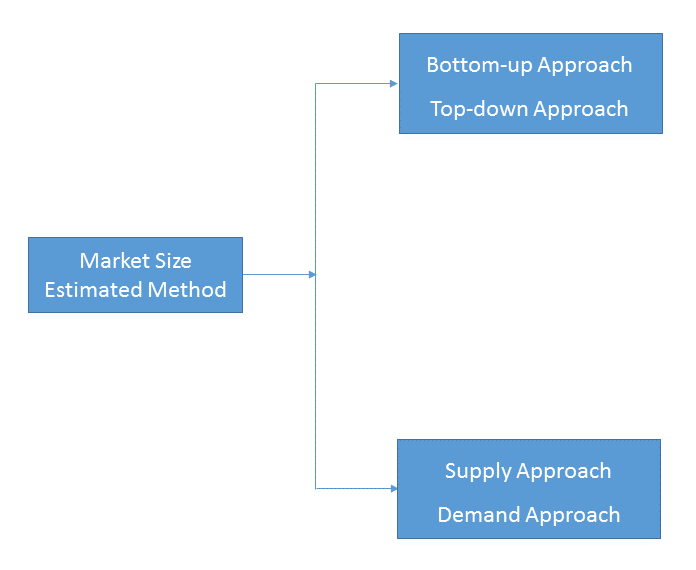
1)Top-down & Bottom-up Approach
Top-down approach uses a general market size figure and determines the percentage that the objective market represents.
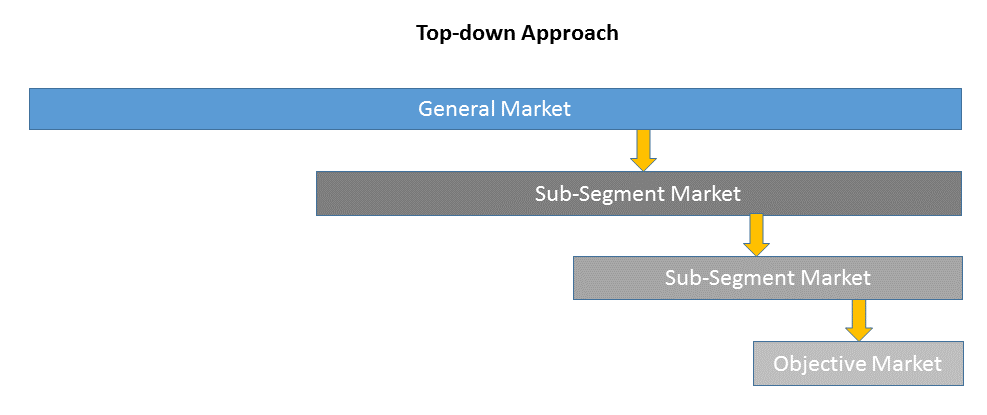
Bottom-up approach size the objective market by collecting the sub-segment information.

2)Supply & Demand Approach
Supply approach is based on assessments of the size of each competitor supplying the objective market.
Demand approach combine end-user data within a market to estimate the objective market size. It is sometimes referred to as bottom-up approach.
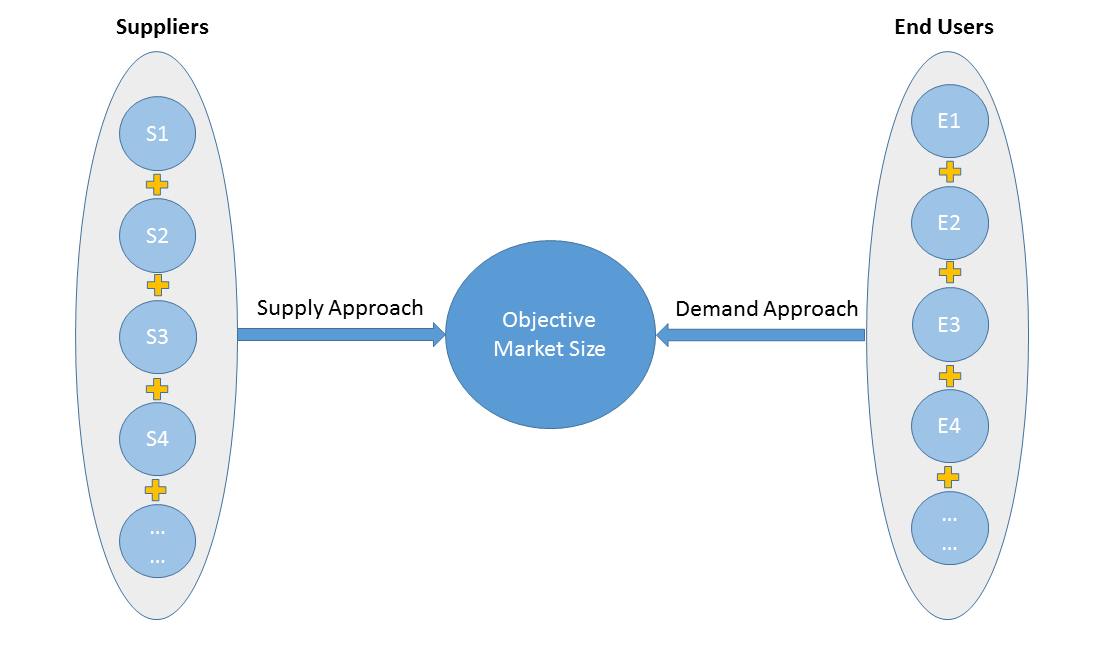
- Forecasting Methodology
- Numerous factors impacting the market trend are considered for forecast model:
- New technology and application in the future;
- New project planned/under contraction;
- Global and regional underlying economic growth;
- Threatens of substitute products;
- Industry expert opinion;
- Policy and Society implication.
- Analysis Tools
1)PEST Analysis
PEST Analysis is a simple and widely used tool that helps our client analyze the Political, Economic, Socio-Cultural, and Technological changes in their business environment.
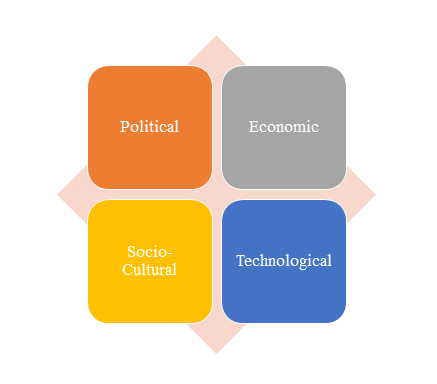
- Benefits of a PEST analysis:
- It helps you to spot business opportunities, and it gives you advanced warning of significant threats.
- It reveals the direction of change within your business environment. This helps you shape what you’re doing, so that you work with change, rather than against it.
- It helps you avoid starting projects that are likely to fail, for reasons beyond your control.
- It can help you break free of unconscious assumptions when you enter a new country, region, or market; because it helps you develop an objective view of this new environment.
2)Porter’s Five Force Model Analysis
The Porter’s Five Force Model is a tool that can be used to analyze the opportunities and overall competitive advantage. The five forces that can assist in determining the competitive intensity and potential attractiveness within a specific area.
- Threat of New Entrants: Profitable industries that yield high returns will attract new firms.
- Threat of Substitutes: A substitute product uses a different technology to try to solve the same economic need.
- Bargaining Power of Customers: the ability of customers to put the firm under pressure, which also affects the customer's sensitivity to price changes.
- Bargaining Power of Suppliers: Suppliers of raw materials, components, labor, and services (such as expertise) to the firm can be a source of power over the firm when there are few substitutes.
- Competitive Rivalry: For most industries the intensity of competitive rivalry is the major determinant of the competitiveness of the industry.
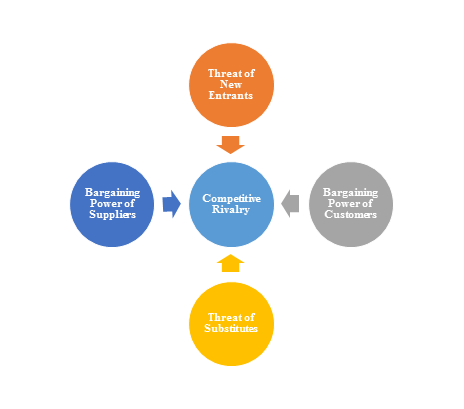
3)Value Chain Analysis
Value chain analysis is a tool to identify activities, within and around the firm and relating these activities to an assessment of competitive strength. Value chain can be analyzed by primary activities and supportive activities. Primary activities include: inbound logistics, operations, outbound logistics, marketing & sales, service. Support activities include: technology development, human resource management, management, finance, legal, planning.
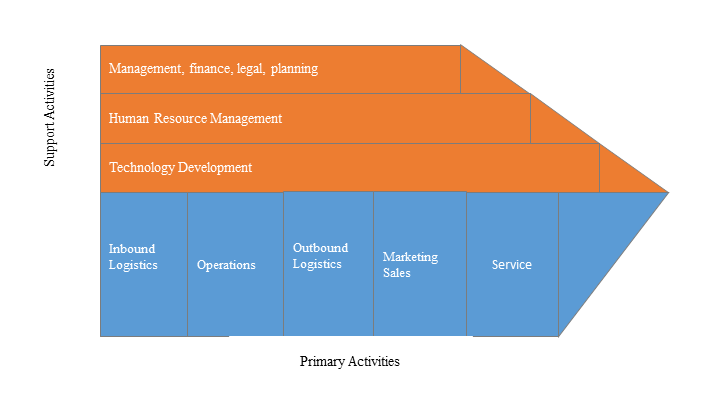
4)SWOT Analysis
SWOT analysis is a tool used to evaluate a company's competitive position by identifying its strengths, weaknesses, opportunities and threats. The strengths and weakness is the inner factor; the opportunities and threats are the external factor. By analyzing the inner and external factors, the analysis can provide the detail information of the position of a player and the characteristics of the industry.
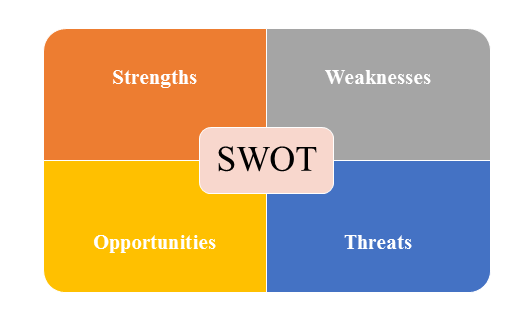
- Strengths describe what the player excels at and separates it from the competition
- Weaknesses stop the player from performing at its optimum level.
- Opportunities refer to favorable external factors that the player can use to give it a competitive advantage.
- Threats refer to factors that have the potential to harm the player.
- Data Sources
| Primary Sources | Secondary Sources |
|---|---|
| Face to face/Phone Interviews with market participants, such as: Manufactures; Distributors; End-users; Experts. Online Survey |
Government/International Organization Data: Annual Report/Presentation/Fact Book Internet Source Information Industry Association Data Free/Purchased Database Market Research Report Book/Journal/News |